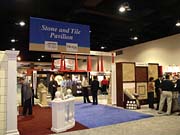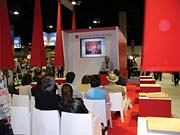
This year, approximately 20,000 building and design industry professionals attended the American Institute of Architects 2003 National Convention and Expo at the San Diego Convention Center in California. The event was held from May 8 to 10, and included more than 700 companies exhibiting an assortment of new products, technology innovations and services. Expo 2003 also featured the Stone and Tile Pavilion sponsored by Stone World and Contemporary Stone & Tile Design.
While the Stone and Tile Pavilion offered displays of new stone products and installation/maintenance materials, it also presented architects with many opportunities to earn Learning Units (LUs) on the exhibit floor. The Marble Institute of America and Italian Trade Commission as well as several suppliers of natural stone and installation products were among those offering these accredited seminars. In total, there were six Specialized Product Pavilions throughout the 145,000-square-foot exhibition hall.
The AIA National Convention and Expo is considered to be the building and design industry's staple event for education, information, inspiration and innovation. In addition to three themed sessions, the event included 148 continuing education programs, 58 tours (including some just for children) and 64 special events as well as the hundreds of exhibiting companies.
The theme of this year's convention was Design Matters! Poetry and Proof -- translating architecture's poetry into proof for clients and the public, and learning how to communicate the value of the magic of good design. The convention kicked off with a themed presentation by internationally recognized architects, Tod Williams, FAIA, and Billie Tsien, AIA, who addressed how their firm translates its passion and inspiration -- its poetry -- into proof.
Other sessions featured Fred Gage, PhD of The Salk Institute and Tom Kelley of IDEO who discussed the "proof" aspects of how design matters, and Robert Ivy, FAIA, of Architectural Record, who lead a panel discussion focusing on the challenges of rebuilding the World Trade Center site. Panelists included Daniel Libeskind, whose Memory Foundations was selected as the design concept; The New Yorker architecture critic Paul Goldberger, Hon., AIA; Frances Halsband, FAIA, AIA New York's past president; and Stanton Eckstut, FAIA, advisor to the New York and New Jersey Port Authority.

Awards announced
Recipients of the 2003 AIA/HUD Secretary's Housing and Design Awards were also honored for their exemplary work in residential, community and housing design. The program was jointly created by the AIA Center for Livable Communities and the AIA Housing Professional Interest Area in partnership with the U.S. Department of Housing and Urban Development (HUD).The projects include a mixed-use space supporting 322 rental units, an outdoor classroom on a freshwater pond, and an accessible independent living complex for people with spinal injuries. The program reflects the ongoing collaboration between the AIA and federal government agencies to highlight the best in residential design and call attention to the importance of architecture in cities and communities across America.
In the Residential Design category, "101 San Fernando" in San Jose, CA, was the winner. Architect: Solomon E.T.C., A WRT Company; Associate Architect: Togawa and Smith Inc.; Client: Forest City Development.
The work on "Outdoor Classroom" at Eibs Pond Park on Staten Island, NY, received honors in the Community Design category. Architect: Marpillero Pollak Architects; Client: The Parks Council.
And the winner of the Alan J. Rothman Housing Accessibility Award was "Independent Communities" in Decatur, GA. Architect: Smith Dalia Architects LLC; Client: Progressive Decatur LLC.
The next edition of the American Institute of Architects National Convention and Expo is slated to take place from June 10 to 12, 2004 at McCormick Place, North Hall (B1 & B2) in Chicago, IL. More information on the event can be obtained at www.aia.org.
